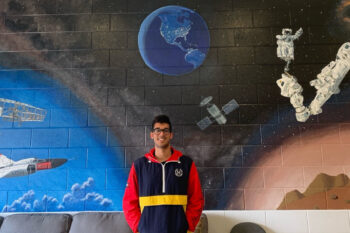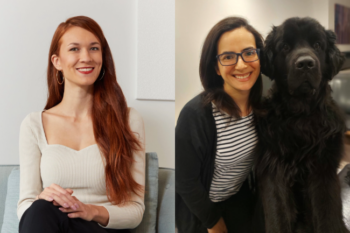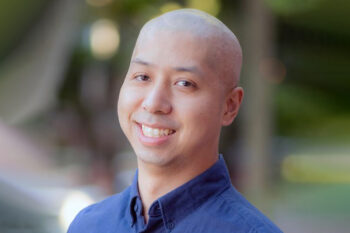Adam De Biasi (Year 3 MechE) was less than a week into his job at Tesla Motors when he was asked to design a completely new mechanical component using a software program he had never used before. “It was like trial by fire,” says De Biasi. “One of my teammates leaned over and said ‘Welcome to Tesla’.”
Drawing on the problem solving techniques he learned at U of T Engineering, De Biasi took a step back, evaluated what he could already do and what he needed to learn, and made a plan. Not only did he successfully complete the assignment, he was grateful for the opportunity. “Tesla understands that interns want to learn as much as possible, and that they want freedom to express their ideas,” says De Biasi, who has since designed and tested many more components related to Tesla’s Model S and Model X electric vehicles. “For me there was no waiting period; from the first day I was in the thick of it.”
Internships are one of the many ways U of T Engineering maintains strong relationships with its numerous industry partners. Currently, a record 782 undergraduate students — including De Biasi — are spending a year or more working with companies, governments or research institutions around the world as part of the Professional Experience Year (PEY) program. The optional paid internship program is the largest of its kind in Canada.
PEY benefits employers just as much as the interns themselves. “We found the PEY program a great way to get some immediate short-term support and also a way to invest in the future talent,” says Steve Titus (MechE 0T3), President & CEO of Aercoustics, a Toronto-based firm that specializes in fostering innovation in acoustics, vibration and noise control. “Since participating in the PEY program starting in 2009, we have not had to recruit full-time staff as several of our students have returned to join our team.”
While PEY is more popular than ever, it is by no means the only internship program at U of T Engineering. The Engineering Summer Internship (eSIP) Program helps undergraduate students access paid work placements during the four months between semesters. For graduate students, the Master of Health Sciences in Clinical Engineering includes a 12-month internship with a hospital or health-care technology company. MEng students can also arrange internships through the University of Toronto Institute for Multidisciplinary Design and Innovation (UT-IMDI). Additional funding for internships at the graduate level is provided by organizations like Mitacs.
For De Biasi, whose ultimate goal is to become an aerospace engineer, the learning opportunity was invaluable. “It helped me grow into a more successful and responsible worker, while providing a sense of what to expect in engineering work,” he says. “Companies like Tesla are successful because they expect first-rate solutions and they know how to motivate their employees to deliver them.”
Other U of T Engineering students who have recently completed internships include:
Morgan Hooper (Year 4 EngSci)
 Hooper spent a year at Aercoustics, where she used measurement equipment and modelling tools to analyze the sound produced by everything from subway trains to symphony orchestras. As a math whiz, she really enjoyed the opportunity to apply her knowledge to industrial problems. “The company was very much geared towards a scientific approach, which meant my background from school was very helpful,” she says.
Hooper spent a year at Aercoustics, where she used measurement equipment and modelling tools to analyze the sound produced by everything from subway trains to symphony orchestras. As a math whiz, she really enjoyed the opportunity to apply her knowledge to industrial problems. “The company was very much geared towards a scientific approach, which meant my background from school was very helpful,” she says.
She was also impressed with the corporate culture, which included an humorous “Mistake of the Year” award the company handed out at its Christmas party. “I liked it because it normalized making mistakes and emphasized the opportunity to learn from them,” she says, adding that she did not win the award herself. “The atmosphere at Aercoustics was just great.”
One of Hooper’s projects involved measuring noise produced by wind turbines. While working on it, Hooper found she really wanted to learn more about the aerodynamic and control aspects of the devices, and plans to continue her studies in that area. “Perhaps I never would have discovered my passion had I not been exposed to it there,” she says.
Read more about Hooper’s experience in this blog post she wrote for Aercoustics.
Mikhail Burke (MSE 1T2, IBBME PhD candidate)
 For a clinical engineer, there aren’t many better places to be than Massachusetts General Hospital, home of the largest hospital-based research program in the world. Burke just returned from a four-month internship there as part of his studies at U of T’s Institute of Biomaterials & Biomedical Engineering (IBBME).
For a clinical engineer, there aren’t many better places to be than Massachusetts General Hospital, home of the largest hospital-based research program in the world. Burke just returned from a four-month internship there as part of his studies at U of T’s Institute of Biomaterials & Biomedical Engineering (IBBME).
Burke’s wanted to learn more about the implementation of technology at the point of care, as well as to get international experience. “Being exposed to the U.S. health-care infrastructure provided a valuable contrasting perspective to my work in Canada.”
Burke was involved in a variety of projects, ranging from configuring and installing new health monitoring equipment to assessing new devices — such as infusion pumps that deliver nutrients and medications directly to a patient’s bloodstream — to ensure they met technological standards and integrated into hospital operational workflow and infrastructure.
While he found the opportunity to apply his technical abilities in a clinical setting extremely valuable, Burke says the most rewarding part was seeing the impact of his work. “By being on intensive care units and seeing patients who are often fighting for their lives, you get an amazing emotional perspective and clarity as to why we do what we do,” says Burke. “Ultimately we are working for the well-being of our fellow man.”
Oyinkansola Romiluyi (Year 4 ChemE)
 The culmination of Romiluyi’s placement at the Calgary office of oil and gas company ConocoPhillips was a 25-minute technical presentation to senior managers. Afterward, her supervisor and mentor told her how impressed the panel had been by her delivery. “That comment made my whole day, week, and 16 months of internship.”
The culmination of Romiluyi’s placement at the Calgary office of oil and gas company ConocoPhillips was a 25-minute technical presentation to senior managers. Afterward, her supervisor and mentor told her how impressed the panel had been by her delivery. “That comment made my whole day, week, and 16 months of internship.”
Romiluyi says that one of the most important parts of her job was communication, something she felt well prepared for as a result of her U of T education, especially her teamwork and group project experiences. “The opportunities I had throughout my undergrad to improve how I wrote, spoke, listened and presented are too many to count,” she says. She worked as an operations engineering intern for a team managing a number of production sites, ensuring that the company produced oil and gas safely, economically, sustainably and in compliance with regulations.
Romiluyi wants to continue working in the energy field, but is not sure yet whether her future lies in oil and gas, nuclear power or renewables. She is very much motivated by her PEY experience. “The internship showed me the pure joy of getting to work alongside brilliant, driven and creative people on projects that yield measurable impact,” she says. “I not only grew in knowledge and skill but in my confidence and professionalism as a chemical engineer-to-be.”
Harminder Sandhu (IBBME MHSc Candidate)
 Sandhu’s placement at Toronto General Hospital focused on making life better not only for patients, but for staff as well. For example, one of Sandhu’s projects revolved around the fact that so many of the devices used in hospitals — from heart rate monitors to IV pumps — use alarms to communicate changes in a patient’s vital signs. When dozens of alarms are going off at once, it’s easy to get overwhelmed, making it harder for doctors and nurses to respond to the needs of patients.
Sandhu’s placement at Toronto General Hospital focused on making life better not only for patients, but for staff as well. For example, one of Sandhu’s projects revolved around the fact that so many of the devices used in hospitals — from heart rate monitors to IV pumps — use alarms to communicate changes in a patient’s vital signs. When dozens of alarms are going off at once, it’s easy to get overwhelmed, making it harder for doctors and nurses to respond to the needs of patients.
Sandhu and her colleagues developed and implemented an alarm management strategy specific to the needs of TGH. The goal was to systematically track alarm data from medical equipment and eliminate unnecessary alarms, reducing caregiver workload and improving patient safety. “When one of the nurses said ‘thank you for doing this for us’, I felt like I had really done something worthwhile,” says Sandhu.
Sandhu plans to continue combining her background in engineering and health care with the eventual goal of becoming a physician scientist. She sees a lot of potential for collaboration between the two spheres. “I like being part of an environment where clinical staff and engineering staff work together to improve the quality of life for patients and even clinical staff,” she says. “I feel that this is the kind of inter-professional collaboration we need at a global scale to address the major issues in health care.”
Amanda Nowicki (Year 4 ChemE)
 An avid camper, skier and hiker, Nowicki knew she wanted to use her expertise in chemical engineering to mitigate environmentally damaging activities. She found the perfect fit at the Ontario Ministry of the Environment and Climate Change (MOECC).
An avid camper, skier and hiker, Nowicki knew she wanted to use her expertise in chemical engineering to mitigate environmentally damaging activities. She found the perfect fit at the Ontario Ministry of the Environment and Climate Change (MOECC).
“It was a fantastic experience and incredibly valuable,” she says. “I performed the same level of work as my colleagues who were professional engineers (under their supervision of course) which was extremely rewarding.”
Making extensive use of her coursework in environmental chemistry and fluid mechanics, Nowicki reviewed proposals for projects ranging from new buildings to waste treatment plants to ensure they complied with environmental regulations.
Nowicki plans to continue working in environmental engineering, and credits her internship with pointing her toward her ideal career path. “Working in this position for more than a year allowed me to see how much I had grown, personally and professionally,” she says. “I am now confident that I have the necessary skills, knowledge and motivation to succeed.”
Kunj Upadhyaya (IBBME MHSc Candidate)
 Upadhyaya is using his expertise in mechanical engineering to help medical students diagnose problems more accurately. He’s working for OtoSim, a company that makes simulation devices for medical training. One of these is essentially a silicone model of a human ear that medical students look inside using a modified otoscope. The otoscope — the hand-held tool used by doctors for ear exams — is programmed to display images recorded from real patients. In this way, medical students can learn to identify the telltale signs of potential problems in a way that is more realistic than studying images in a textbook, yet simpler than finding patients with those specific pathologies.
Upadhyaya is using his expertise in mechanical engineering to help medical students diagnose problems more accurately. He’s working for OtoSim, a company that makes simulation devices for medical training. One of these is essentially a silicone model of a human ear that medical students look inside using a modified otoscope. The otoscope — the hand-held tool used by doctors for ear exams — is programmed to display images recorded from real patients. In this way, medical students can learn to identify the telltale signs of potential problems in a way that is more realistic than studying images in a textbook, yet simpler than finding patients with those specific pathologies.
The goal of Upadhyaya’s project is to help design the next iteration of the company’s device, making it even easier for more medical schools to integrate into their curriculums. He has been working out of the company’s office in Toronto’s SickKids Hospital. “Working directly with surgeons and getting their feedback as we’re designing it has been really good,” he says. The relationship has worked out so well that Upadhyaya is extending his 4-month internship for another two months.
Helping doctors learn to diagnose problems more accurately is, according to Upadhyayay, very rewarding. It has also validated his choice to work in the biomedical engineering field. “This is something that I can definitely see myself doing when I graduate,” he says.



